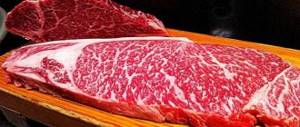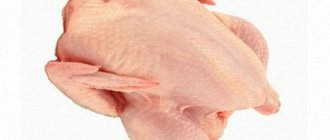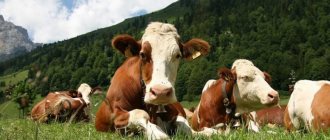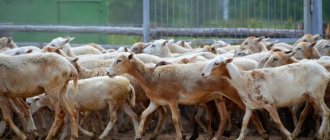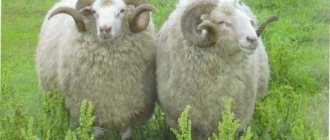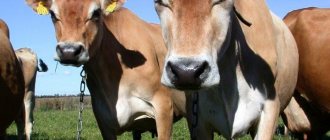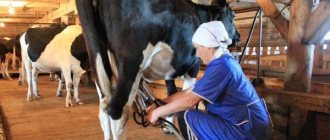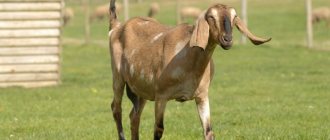Products – Black Angus
The meat of young bulls of the beef breed has special taste and structural qualities that are not present in other varieties of beef. The cow breed was first bred in Scotland, in the county of Angusshire, back in the 19th century. The cattle received a name in accordance with the geography of breeding; in professional circles it was called “Aberdeen Angus”. At first, red and black bulls were eaten. Later, due to the tendency of black cows to quickly gain muscle mass, they were mainly subject to widespread breeding.
Beef (beef) Black Angus: breed description
With proper care, Black Angus can quickly gain weight. Producers use grain rather than straw for feed, resulting in animals becoming 1.5 kg heavier per day. After professional cutting of the carcass, up to 70 percent of the animal’s weight was used.
Black Angus Beef Marbling
The main quality of steak meat, which is why it received the name marble, is the presence of a rich fat layer. It is evenly distributed throughout the volume of clean pulp, creating a pattern similar to that formed on marble.
Due to the fact that the fat is distributed throughout the entire volume, the meat remains juicy and flavorful after cooking. The advantage of Black Angus is its genetics, thanks to which almost all pieces of the carcass are characterized by increased marbling.
Centuries of experience in breeding and proper care of animals allows us to use natural methods for increasing the fat content of meat.
4 months before the slaughter of cattle, they begin to feed them mainly with high-calorie food.
Marbling of Black Angus meat
What is marbled beef? This is the name given to the meat of the Black Angus or Aberdeen Angus cattle breed. Thin layers of fat are formed in the muscle tissue of these animals, from which a marbled pattern is formed. The more fatty fibers there are on the meat, the juicier and more tender it is.
The formation of layers inside the muscles is explained by the genetic predisposition of Aberdeen Angus and proper feeding of the animals. 3-4 months before slaughter, when the weight of the bull is at least 350 kg, it is transferred from fresh grass to grain-fed. This contributes to the formation of layers of fat inside the muscles. In cattle of other breeds, fat layers do not form, and fat grows on top of the muscle tissue. Their meat will be much tougher, and the finished steak will probably taste rubbery.
It is thanks to the fatty inclusions that Black Angus beef, when cooked, acquires the desired juiciness and rich taste. The fat melts when heated, soaking the entire piece of beef with this juice. The steak literally melts in your mouth.
How to determine the freshness of marbled beef
After cutting, all pieces are placed in vacuum packaging. They can be stored at favorable temperatures for up to 45 days. You can verify the freshness of meat by a simple check, which consists of visual observation. Upon inspection:
- The meat should not be wet.
- Have a sour or foul odor.
- The meat of an adult should be bright red, and the meat of a young one should be slightly pale.
- The veins should have approximately the same appearance throughout the entire structure.
Black Angus Miratorg
In Russia, Miratorg is the largest producer of Black Angus meat products. There are more than 350 thousand livestock units on the company's pastures.
One of the advantages of the company is the careful selection of animals, which were collected from the best representatives of the breed. Each individual bull has appropriate documents confirming its pedigree.
The high-quality work of management, cowboys and veterinarians has brought Miratorg to a leading position in this industry not only in Russia, but also in the world.
Black Angus – organic marbled beef “Ugleche Pole. Organic Market"
If until recently Australia and the USA were considered the sole market leaders, now Russian livestock breeders are actively “mastering” the breed - excellent Aberdeen Angus cows graze on our meadows. Temperate and northern climates suit them perfectly - animals do not experience difficulties with acclimatization in all natural zones. It was Black Angus that became the main meat breed bred in the organic farms “Ugleche Pole. Organic Market. The Aberdeen Angus breed of cows is a leader in the quality and taste of meat and steaks. We chose them because Angus beef is famous throughout the world for its delicate taste and bright aroma. This is one of the best breeds of marbled beef - the meat delicacy has no equal, it is No. 1 in the world.
Popular products
Ribeye
The most popular and interesting steak. Ribeye is the part of the thin edge containing the largest amount of fat. Thanks to this, the structure of the meat looks attractive, and after cooking it remains soft and juicy.
In addition, this steak is difficult to spoil when cooking. It can be fried in a frying pan or over coals without fear of overcooking.
New York steak (striploin) The second most popular cut of thin sirloin. Its peculiarity is that it contains less fat, but the muscle that is used to prepare it is distinguished by its softness.
Due to the presence of a large amount of red fiber, this beef contains an increased amount of nutrients consumed by athletes and people watching their figure.
Tenderloin
The second name of this steak is “Chateaubriand”. It is the most expensive meat part of the entire carcass. Due to the fact that the muscle used for its preparation is practically not involved in vital activity, the steak is especially tender. Also, this product can be found on the shelves under the name “Fillet Mignon”.
Almost 70 percent of the bull carcass is used in cooking. Its structure depends on the location of a particular muscle. The whiter, tender pieces are the softest and juiciest, and they also cost accordingly. The variety of Miratorg products is not limited to steaks. Black Angus beef can be used to prepare a wide variety of deli meats.
Steaks
One of the most expensive premium steaks is Ribeye. It is cut from the thick end of the animal from the 5th to 12th rib. The dish is a regular guest on the menus of the most expensive and sophisticated restaurants. Depending on the class and degree of marbling, a Ribeye steak from Miratorg can cost from 2400 to 3000 per 640 grams of fresh product.
Well, the most expensive Miratorg product is the Chateaubriand steak. The meat used for it is located in the psoas muscle. In other words, it is the highest quality and most nutritious beef available on both sides of the animal's back.
The cost of Top Choice beef is around 3,800 rubles per 640 grams, and if we are talking about the Prime category, then you need to be prepared for 4,000+ per package.
Burgers
The second most popular product from Miratorg made from Black Angus meat is burgers. A balanced amount of fat to pulp makes the taste of the finished steaks unique and rich.
Products can be sold in various forms. This can be either regular minced beef, which will cost up to 200 rubles per 200 gram portion. Specialized, for the production of which the most expensive pieces were used, minced meat from the thin part, or Striploin, is sold at 500 rubles per 360 grams.
Carpaccio and bacon
Prepared in a special way, almost raw meat has a specific and unusual taste. Marinades used during the preparation of carpaccio make the meat safe for consumption. In many restaurants, the dish is classified as premium. Miratorg allows an ordinary person to purchase an exquisite product at a price of 150 to 400 rubles per 100 gram portion.
In some countries, no breakfast is complete without a piece of fried bacon. Thin-cut Black Angus beef bacon outperforms most of its popular pork counterparts. In addition, the Miratorg product is less fatty and contains a minimum of salts, which makes it a dietary and healthy product. The cost of a package weighing 0.19 kg today remains at 175 rubles, and the more refined New York bacon is sold at 320 rubles per 0.16 kg.
Historical background and origin of the breed
The Black Angus bull breed was bred in the 17th century in the Scottish counties of Aberdeen and Angus, from which the name comes. Initially, these animals were not eaten, but were used for earthworks, so their meat was tough and stringy. However, by crossing several breeds, breeders managed to ensure that marbled beef obtained from Black Angus became tender and soft.
At the end of the 19th century, American farmers became interested in bulls, and the breed was brought to Kansas. A few decades later, Angus began to be grown for export and from the USA came to Canada and Argentina. A little later they were brought to New Zealand and Australia from Great Britain.
Over the past few decades, Angus have ceased to be something outlandish, and large farms for their cultivation now operate throughout Russia: in the Volgograd, Voronezh and Bryansk regions, Stavropol Territory, Volga region, etc.
Specialists of the online store "Gurmanin"
This breed appeared in the USSR only in the middle of the 20th century.
after N. Khrushchev's diplomatic visit to the USA. He appreciated the unsurpassed taste of marbled beef and ordered the establishment of a special livestock farm, where bulls of a special Aberdeen-Angus breed were delivered from Europe. But since the country placed its main emphasis on dairy production, they did not gain much popularity in those years. And only in the last few decades, Angus have ceased to be something outlandish, and large farms for their cultivation now operate throughout Russia: in the Volgograd, Voronezh and Bryansk regions, Stavropol Territory, Volga region, etc.
Cooking method
One of the qualities that characterizes a finished steak is the degree of frying. There are six of them in total:
- Very rare – almost raw meat, lightly fried on both sides.
- Rare – rare steak.
- Medium rare – lightly roasted with pink juice.
- Medium – medium roast, characterized by a small amount of juice.
- Medium Well – the meat is fully cooked, but not dried out.
- Well Done – Fully cooked, dry meat.
Cooking
Depending on the level of marbling, the methods of preparing steaks are different. Based on the number and density of distribution of veins in the pulp, the product has a class level that is indicated on the packaging. There are levels of marbling such as:
- Prime is the most marbled meat.
- Choice – average level.
- Select – the least amount of fat.
When preparing, you need to take into account the characteristics of each category. It is not advisable to over-fry Select level beef, as the resulting dish may turn out tough and dry. Prime level is easy to prepare because it is very difficult to dry it out. A large amount of fatty inclusions will make beef, even medium well roasted, tasty and juicy.
Any sufficiently heated surface or grill grate is suitable for cooking. Before placing meat on it, it is better to prepare it.
Preparation stages:
- All excess moisture is removed from the surface. A paper towel or napkin is suitable for this.
- The preparation is seasoned. It is better to use coarse salt and natural spices for this.
- The seasoned stack is marinated for 10-15 minutes.
Next, the frying process begins.
Steaks are fried on a hot and oiled surface. Time required to achieve a certain doneness:
- Rare - to get tender meat with blood, you need to fry each side for 2 minutes, then you need to give it time to rest, 10 minutes is enough.
- Medium – Medium done, should last 3 minutes on each side. Let rest for 5-8 minutes.
- Well – Fully cooked. The steak should be cooked for 4-5 minutes on each side. It can be sent to the table almost immediately.
Marbled Black Angus Beef
Historical fact
N.S. was the first resident of the USSR to appreciate the taste of marbled beef. Khrushchev during his business visit to the USA. Upon returning to the Union, the Secretary General asked his personal chef to prepare beef for him using the same technology. However, in terms of taste, the dish was inferior to the American steak, since the secret of marbled beef lies not in the recipe for its preparation, but in a special type of meat, which allows the finished dish to convey all the best taste properties.
Subsequently, by decree of N.S. Khrushchev, a specialized livestock farm was equipped, to which bulls of a special breed were supplied from Europe; later it served as the main source of marbled meat.
The secret of marbled beef
Marbled beef is a special type of red meat containing pronounced layers of fat, giving it not only a delicate and juicy taste, but also a color similar to marble. In this case, the fat is pure white and is evenly distributed throughout the steak. During the technological processing, these fatty layers are melted, due to which the meat becomes tender and soft.
Try the Black Angus ribeye steak, supplied especially for you from our own Koenigsbeef farm in the Kaliningrad region.
Japan is the birthplace of marbled beef
The technology for producing this delicacy first appeared in Japan. There are about 120 varieties of marbled meat, depending on the number of places where it is produced. The most famous Japanese marbled beef is called Wagyu - an exquisite type of marbled beef obtained from Japanese cows raised using special technology. The term Wagyu primarily refers to a family of several breeds of steers that are genetically predisposed to intense marbling of meat and high levels of oleic acids (omega-3 and omega-6). In the middle of the 19th century. In Japan, the centuries-old ban (since 1635) on eating meat was lifted. This period can be considered the birth of Wagyu meat.
Goby, goby, strife
Marbling of meat is achieved through selection. Cattle breeds such as Angus, Hereford, Murray Gray, Short Horn, Wagyu, and some dairy breeds have a significantly higher predisposition to marbling in their meat compared to other breeds. Currently, breeds of these valuable animals are bred in Australia, New Zealand, Argentina and Russia.
In our stores you will always find marbled Black Angus , supplied especially for you from the Koenigsbeef farm in the Kaliningrad region.
Meet Black Angus
A specially bred black Aberdeen Angus meat breed. It is considered the best (elite) meat breed. The bull meat supplied to our stores is grown on a farm in the Kaliningrad region. Black Angus are freedom-loving animals and do not like to be tied, so they are raised exclusively on pastures (free grazing), which means without the use of intensive production methods (no growth hormones, antibiotics). That is why the meat of such bulls is an order of magnitude more expensive than ordinary beef.
The devil is in the details
Marbling also depends on the fattening of the animal. A grain diet including corn or barley lasts about 200–300 days. Due to this, the color of the veins changes from yellowish to white.
There are other methods of producing marbled meat in Japan: bull calves are fed with alfalfa (a plant) and wheat, given special beer (!), and then suspended over a stall so that the animals do not “shake” the precious fat. Physical inactivity (limited mobility) is compensated by massage (!), and in order for the bull not to experience stress, classical music must be played for him.
Our marbled beef is grown in more humane conditions - in the meadows of the Kaliningrad region. This is a feature of the Black Angus . At the same time, marbled meat is not inferior in quality to Wagyu
Classification of marbled beef
The USDA grading system, accepted worldwide, distinguishes eight categories of marbling (in descending order):
- Prime (top of the top!)
- Choice
- Select
- Standard
- Commercial
- Utility
- Cutter
- Canner
In the USA, the carcass is assigned a certain rank on the meat quality scale (quality grading) and on the yield grading scale.
The quality rank is established depending on the degree of marbling of the meat and the age of the animal. The degree of marbling is determined in the following way: the ribeye cut is cut crosswise in a strictly defined place (in the area of the 12th rib) and the cut of the cut is compared with reference templates. Based on the comparison results, the entire carcass is assigned one of 10 marbling categories. The higher the marbling of the meat, the higher quality it is considered.
The second criterion for assigning a quality rank is the age of the livestock. Each carcass falls into one of five age categories, with the highest category ("A") being animals slaughtered between 9 and 30 months of age. The lowest category (“E”) is age over 96 months. Age plays an important role, since as an animal ages, its meat becomes coarser and changes its color from uniformly red to a darker, almost gray, with a noticeable granular structure.
Depending on the combination of marbling level and age group, the meat is assigned a certain quality rank. The highest rank is Prime. Next in descending order are: Choice, Select, Standard, Commercial, Utility, Cutter and Canner. Beef of the last three categories is practically not sold in retail and is used mainly for industrial processing. The first three categories (Prime, Choice and Select) can only be obtained from young cattle of the first age group (“A”). Therefore, they differ solely in the degree of marbling. Prime is a very narrow category: the first (highest) degree of marbling. Choice - degree of marbling from 2 to 4. The Select category allows a degree of marbling from 5 to 6. Subsequent categories are assigned to meat with a lower degree of marbling, obtained from adult animals. It is worth noting that only 2-3% of all American beef falls into the Prime category.
The most marbled steaks are located in the dorsal part of the animal, the muscles of which receive minimal stress during its life, when compared, for example, with the leg muscles.
In the GASTROMAN chain of stores, the quality of marbled beef is Choice, which is confirmed by certificates from the Koenegsbeef farm.
Determining the quality of Black Angus
1. The meat should have a richer red color compared to regular beef.
2. If you touch the meat with your palm, it should remain dry. There should be no mucus on the surface of the meat
3. The meat has a pleasant smell (not sour)
4. Even distribution of veins throughout the steak
The highest gastronomic “chic” of 2021 is considered to be a cooked steak in a vacuum (using cookvac technology): olive oil is poured into a special cooking apparatus, a Black Angus steak is placed, spices are added, and cooked at low temperature. The meat literally “melts in your mouth”!
Ribeye
Ribeye is the most marbled of the premium cuts. The name “ribeye” comes from two English words rib-eye, i.e. rib and eye. The rib is where the cut comes from, and the eye is the cross-cut shape that the steaks inherit. The abundance of fatty layers, which quickly “melt” when fried, makes ribeye the juiciest and most unpretentious to cook of all steaks. Ribeye is a versatile steak: it can be cooked at home in a frying pan and served as a delicacy dish, or it can be grilled over coals and eaten on a picnic.
New York steak (striploin)
Striploin, or thin sirloin edge, contains in its name an exact definition of its essence. In English, strip-loin is literally a sirloin strip. This cut is shaped like a strip with a conventionally rectangular and rather elongated cross-section. Its marbling is less pronounced, but compared to ribeye, the flesh of striploin consists of larger and very delicate fibers of muscle tissue and has a more concentrated and bright beef taste. For this reason, striploin steak is traditionally considered a “male” dish, although this identification is very conditional. Striploin steak contains a thick strip of fat on top, without which the steak is called "New York" - one of the most popular steaks in America.
Tenderloin
Tenderloin is a tenderloin, the most expensive and valuable cut, which is located under the striploin, obtained from a unique muscle that is practically not involved in motor activity. Therefore, filet mignon or sirloin steak is the most tender meat with a thickness of 6–8 cm. The famous Chateaubriand and Filet Mignon steaks are prepared from the sirloin.
Steak "Cowboy"
“Cowboy” steak or “ribeye on the bone” is a cut from the most “marbled” part of the bull carcass, only with the rib bone preserved. It is also called Rack bone-in Tommahawk. This cut produces juicy and very colorful steaks weighing approximately 1 kg. Since the marbling of the beef near the bone is quite intense, the recommended degree of doneness for these steaks is medium well.
Shorthole
Shortloin is a cut from the lumbar region.
T-bone steak
T-bone steak gets its name from the T-shaped bone that separates two different types of meat at the border of the back and lumbar parts. T-bone steak takes a long time to cook due to its size.
Steak degrees of doneness
There are six degrees of doneness for steaks:
- Very Rare – very raw
- Rare – raw with blood
- Medium Rare – medium raw with a predominance of pink juice
- Medium – medium-roasted meat with pinkish meat juice
- Medium Well – almost done
- Well Done – fully cooked until completely dry.
How to cook
According to the above classification, the Prime category is assigned to the most marbled steaks, followed by Choice. The Select category assumes low marbling. This type of meat can be grilled, but it must be cooked gently if you want to keep the meat juicy and tender. Prime steaks should be grilled over high heat until medium rare-medium well done for excellent results.
Typically, the Japanese chef prepares marbled meat right in front of the visitors on a large stove - teppan, or hibachi table, as the Americans call it. These are special brazier tables located next to the tables. The meat is fried in vegetable oil with the addition of sesame seeds and spices.
Marbled beef is used to prepare shabu-shabu (boiled thin pieces of meat, vegetables, noodles) and sukiyaki, whose history goes back 150 years. In restaurants you can most often find sukiyaki nabe - boiled marbled meat with bean curd, vegetables, noodles and raw egg.
Marbled Wagyu beef is perfect for preparing a classic steak, but it is worth remembering that, due to its exceptionally tender structure, the meat cooks in a matter of minutes.
The best way to cook steak is to sear it in a hot cast iron skillet. Another method is to quickly fry at high temperature and further bring it to the desired degree of doneness in a preheated oven.
Price and product reviews
There are two opinions regarding Miratorg products. Those who appreciate the taste of real and high-quality beef and are willing to pay money for it. In return, they receive meat, which is difficult to find in the vast expanses of the Russian Federation. In addition, various price categories allow even poor people to try meat delicacies. Words from a regular customer: “We regularly buy this product; when prepared correctly, the taste is simply indescribable.”
The second group of people note the unreasonably high cost of Ribeye, Striploin and Chateaubriand steaks. After the purchase, many expressed dissatisfaction with the product, as they believed that they had purchased too fatty meat for 4,000 rubles. So one housewife writes: “For such a high price I bought beef containing 50% fat.”
